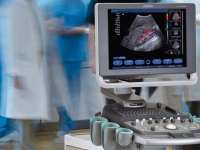Of all the abdominal tumors detected by ultrasound, only two tumors can be reliably diagnosed without the use of additional techniques: renal cell carcinoma and renal angiomyolipoma. To diagnose hemangiomas and focal nodular hyperplasia, it is necessary to use ultrasound with increased contrast. For the rest of all tumors, the differentiation of benign and malignant nature is possible only when the detection of typical signs of a particular type of tumor or the detection or exclusion of signs of malignancy. There are always two rules to keep in mind:
- Only cytological or histological diagnosis is final
- Detection of signs of a benign tumor by histological or cytological examination does not rule out malignancy.
Predictable criteria: some tumors have a characteristic type of vascularization in the SCC or characteristic kinetic parameters of blood flow during an ultrasound with increased contrast. These features can be used to differentiate malignant and benign tumors.
Undefined criteria: these criteria relate to the general appearance of tumors, organ changes, and concomitant phenomena - changes in shape and echo structure, including hypoechoic contour (halo), calcifications, thinning, deformation, and displacement of the organ can accompany both malignant and benign processes.
Conclusion:
- These ultrasound data are nonspecific.
- Nevertheless, during the study, it is appropriate to pay attention to the displacement of the organ, the presence of signs of "halo" and microcalcifications, as these data may guide the diagnostic search. To distinguish it is appropriate to use the SCC.
Defined criteria: infiltrative growth, local-regional metastases, and distant metastases are indisputable criteria of malignancy. During the study, it is advisable to purposefully look for these signs, which can often be detected by ultrasound.
Suspicion of tumors or metastases to the liver:
- Ultrasound, SCC, contrast-enhanced ultrasound (contrast-enhanced ultrasound): SCC is an important method for diagnosing focal liver changes and is often combined with ultrasound with CC. Typically, different types of liver tumors are characterized by different types of vascularization. Ultrasound with CC allows us to provide a clearer description of focal liver tumors and facilitates their detection, compared to conventional ultrasound
- Hemangiomas: In normal tumors, these tumors do not show or have almost no internal vessels, except in the case of small hemangiomas with high blood flow (capillary hemangiomas). The final diagnosis can be made by ultrasound with CC, as the latter allows to detect the same characteristic signs of progressive peripheral centrifugal enhancement of the contrast node as CT or MRI.
- Adenomas: vascularization is detected; during the contrast-enhanced ultrasound evaluation in the arterial phase the hyper-contrast status is defined, a however typical characteristic of vascularization is not found.
- Focal nodular hyperplasia: characteristic vascularization like wheel spokes. At CDI, and the ultrasound with contrast - even more intensively, hyper contrasted, early contrast of radially directed arteries, centrifugal filling of arteries is found.
- Primary liver tumors (hepatocellular carcinoma) are vascularized. At ultrasound with contrast, the hyper-contrast "chaotic" vessels are defined. A combination of different types of angiogenesis is also often found.
- Metastases: in most metastatic tumors, blood vessels are not detected either by CDC or by ultrasound with CC. Exceptions are metastases of endocrine tumors and renal cell carcinoma, some of which are characterized by marked vascularization.
- Focal fatty infiltration can be mistaken for liver metastases, but CDC helps to differentiate malignant and benign tumors: the branches of the hepatic veins and veins of the portal system pass through the form without changing.
- CT: diagnostic accuracy of ultrasound in the detection of malignant liver tumors and metastases is slightly less than CT (accuracy is 80-95% and 95% for CT angiography). The sensitivity of ultrasound with UV in the detection of liver tumors is comparable to CT angiography or even superior to it.
- MRI: this technique allows us to differentiate hemangiomas and cysts with metastases with reasonable accuracy. However, MRI complicates the differential diagnosis of liver adenoma and hepatocellular carcinoma with metastases, as well as focal nodular hyperplasia with liver adenoma and hepatocellular carcinoma.
Suspicion of carcinoma of the bile duct or gallbladder:
- Ultrasound:
- The hepatic duct and the common bile duct can be monitored by ultrasound to the site of obstruction, which can then be assessed with magnification.
- Gallbladder carcinoma is easily detected by ultrasound, but at this stage is already inoperable due to early lymphogenic metastasis and local spread.
- At full germination of a channel by a tumor detection of concrements is difficult
- ERCPG; TGAB (if necessary).
- CT: in tumors of the small ducts usually does not work, but in tumors of the gallbladder has high accuracy. CT scans can diagnose liver infiltration by an isoechoic tumor, which is difficult to detect on ultrasound.
Suspicion of a pancreatic tumor:
- Ultrasound examination: the sensitivity of ultrasound diagnosis is 72% (for tumors the size of ‹2 cm - only 32%, which is compared with CT).
- Endosonography: maximum accuracy, 100%.
- ERCP: diagnostic accuracy of approximately 70%, as tumors of the pancreas, are almost always formed from the epithelium of the ducts.
- Fine-needle aspiration biopsy with cytological and histological examination: high accuracy, ›90%. THAB is not indicated for operable tumors, which is associated with the likelihood of a false-negative result and the risk of dispersal of cancer cells along the needle.
- Surgical intervention with histological examination: small hormone-producing tumors (insulinomas) cannot be detected by non-surgical techniques (including endosonography), so surgery is required for diagnosis.
- Tumor markers Ca 19-9: a positive test result is not a criterion for the diagnosis of malignancy, as an increase in the level of markers is found in benign tumors and pancreatitis. In these cases, it is recommended to control the level of markers in the dynamics.
Suspicion of kidney tumors:
ultrasound criteria for malignancy:
- Frauscher classification: the outstanding criteria for malignancy are peripheral vascularization and "spotted" intratumoral vascularization. Grade 3 or 4 according to Frauscer indicates renal cell carcinoma; grade 2 is characteristic of angiolipoma and other types of tumors (non-contrast ultrasound):
- Grade 0: the absence of "halo" and vascularization of the tumor
- Stage 1: peripheral vascularization
- Stage 2: peripheral vascularization and one intracranial vessel
- Stage 3: peripheral vascularization and 2-4 intra-tumor vessels
- Stage 4: peripheral vascularization and more than 5 intra-tumor vessels.
- Muster classification: in addition to peripheral perfusion, the presence of a vessel feeding the tumor is determined. According to this scheme, the combination of peripheral vascularization and the vessel feeding the tumor with 96% sensitivity indicates a malignant tumor.
Suspicion of a malignant tumor of the thyroid gland:
there are no clear ultrasound criteria for differentiating adenomas and thyroid carcinomas. Both types of tumors are characterized by complete or incomplete vascular halo and intra-tumor vessels (in adenoma the halo is usually closed, and in carcinoma intermittent). In metastatic tumors and lymph node metastases, duplex scanning can visualize "shimmering vessels" with a high resistance index (RI), which indicates a malignant tumor.
Suspicion of tumors of the gastrointestinal tract:
- Ultrasound examination: especially helps in detecting hidden tumors in bedridden elderly people. Ultrasound is a very effective method of screening the condition of the entire colon (identified by folds and gaustras), and also allows you to easily detect tumors that are accompanied by clinical symptoms. At KDK aberrant (spotted)
- Endoscopic examination: the subject of endoscopic diagnosis is small tumors and polyps.
- Tumor markers (cancer embryonic antigen): used during preoperative preparation and for follow-up.
Suspicion of malignant pleural ascites or malignant ascites:
- Ultrasound examination: when using high-frequency sensors and increasing ultrasound can detect irregularities of the pleura or peritoneum, which may indicate carcinomatosis with high accuracy.
- The diagnosis can be confirmed by TGAB, pleuroscopy, pleural biopsy, or laparoscopy. (CT is ineffective for the diagnosis of carcinomatosis of the peritoneum and pleura).tumor vessels that specify a malignant tumor come to light.
Suspicion of lymph node metastases
Ultrasound signs of malignancy are:
- Peripheral lymph nodes: longitudinal/transverse axis ratio ‹2: 1.
- Pathological tumor vessels: in the presence of all four criteria, the prognostic probability of diagnosing a malignant tumor is 94%. At the same time, reactively enlarged lymph nodes are usually characterized by root, longitudinal, peripheral, or point vascularization.
- Types of vascularization that indicate a malignant tumor:
- Multiple vessels
- Displacement or aberrant course of intranodal vessels.
- Focal avascular areas.
- Detection of subcapsular vessels







